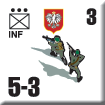| 1940: Polish Exiles
Scenario Preview, Part Four
By Mike Bennighof, Ph.D.
February 2024
 We had extra space in the 1940: Polish Exiles book, and one of my perks as owner-creator at Avalanche Press is that I can decide to fill that extra space with more history and scenarios instead of cutting the book short. We had extra space in the 1940: Polish Exiles book, and one of my perks as owner-creator at Avalanche Press is that I can decide to fill that extra space with more history and scenarios instead of cutting the book short.
So I added a fourth chapter. I’d already done the research on the anabasis of the Polish 2nd Rifle Division, to write the background piece for this book, and had noted potential scenarios. That brought 1940: Polish Exiles to just the right length to fill its allotted pages, without cutting. This is why I do this job: to dive into Polish histories of their troops in France, tales of obscure battles no wargamer ever knew existed (they’re obviously not “unknown,” a truly stupid and insulting term – 30,000 guys fought on the Clos du Doubs in June 1940 and they certainly knew there was a battle). I had a good time with it.
I don’t want to publish mediocre crap just to feed the beast or offer up more-games-more-fast that will be forgotten next Tuesday. You can get games like that anywhere. I take pride in our work, and when there’s an opportunity to give y’all something better, we need to take it. 1940: Polish Exiles is a fine book, and helps flesh out the story of the 1940 campaign with some incidents that might not be very well-known.
Let’s have a look at our final chapter.
Chapter Four
Clos du Doubs
The Polish 2nd Rifle Division (sometimes translated as “Chasseur” or “Fusilier” Division) had finally been committed to combat in mid-June 1940, after the Battle of France had been decided. At this point, all that it could accomplish was to hold off German attacks while French units withdrew and evaded German capture. The French high command detached four of the division’s nine battalions to support French units, and the remainder pulled back to positions just inside France’s border with Switzerland.

Polish infantrymen on exercises. Spring 1940.
There, division commander Bronislaw Prugar-Ketling chose a very strong natural position in the wooded hills known as the Clos du Doubs. Both of his flanks lay on the Swiss border, with the Doubs River forming part of his line. There, his division would stand until Polish commander-in-chief Wladislaw Sikorski authorized internment in Switzerland. The Poles would not flee the battlefield unless ordered to do so.
Scenario Thirteen
First to Fight
18 June 1940
 In front of the main line of Polish resistance, the Algerian 7th Spahi Regiment and part of the Polish 4th Rifle Regiment formed a screen in front of the Polish main line of resistance. The cavalrymen had patrolled this border during the previous winter and had good knowledge of the terrain, while the Poles were reluctant to cross into Swiss territory without having first fought the Germans. Soon enough the German XLI Motorized Corps arrived, willing to give them the opportunity. In front of the main line of Polish resistance, the Algerian 7th Spahi Regiment and part of the Polish 4th Rifle Regiment formed a screen in front of the Polish main line of resistance. The cavalrymen had patrolled this border during the previous winter and had good knowledge of the terrain, while the Poles were reluctant to cross into Swiss territory without having first fought the Germans. Soon enough the German XLI Motorized Corps arrived, willing to give them the opportunity.
Conclusion
The German attack drove back the Algerians, who then passed through the Polish positions. These held back the Germans through the afternoon, and under the cover of darkness the Poles pulled back to their division’s main line of resistance about five kilometers to the east. The Poles had held their ground in their regiment’s first clash with the enemy, even as the Polish high command ordered them to abandon the fight and withdraw into Switzerland.
Notes
It’s a German frontal assault, but first they have to get past a screen of Spahi cavalry, who are pretty tough, and then fight their way through a Polish battalion, who are even tougher. The Germans do have good mobility, but it might not help.
Scenario Fourteen
Clos du Doubs: Right Flank
19 June 1940
 By the second day of the German attack on the Polish redoubt, a second division had arrived and slipped into position alongside the 29th Motorized Infantry Division. With the Swiss border looming behind the Polish positions, the Poles could have been contained there and allowed to either surrender or enter internment without the need for more casualties. Heinz Guderian, commanding several German corps as part of his newly-formed Panzer Group, ordered an attack. By the second day of the German attack on the Polish redoubt, a second division had arrived and slipped into position alongside the 29th Motorized Infantry Division. With the Swiss border looming behind the Polish positions, the Poles could have been contained there and allowed to either surrender or enter internment without the need for more casualties. Heinz Guderian, commanding several German corps as part of his newly-formed Panzer Group, ordered an attack.
Conclusion
Prugar had stationed the 6th “Kresowy” (“Borderland”) Rifle Regiment on this flank, supported by one light and one medium artillery battalion. The Poles had a full day to prepare their positions while the Germans probed the division’s other flank, and eagerly awaited a chance to fight their blood enemies.
The Germans attempted a two-pronged attack, with one group trying to out-flank the Poles by advancing north of the Doub River and then crossing behind the Polish front line, while the other pinned the Poles in place with a frontal attack. Both efforts failed, as the Germans did not get over the river while the Polish front held its ground.
Notes
This is an odd situation, with the Poles having anchored their right flank on a major river, but the Germans have the opportunity to move along that side of the river and try to outflank the Polish from with a river crossing behind them. But the Poles know that they can do this and can prepare, if they’re willing to spread their forces thin to account for a maneuver that may never happen.
Scenario Fifteen
Clos du Doubs: Left Flank
19 June 1940
 Prugar expected the German 29th Motorized Infantry Division to renew its attack on the next day, and had his 4th “Warsaw” Rifle Regiment ready to meet them with well-prepared positions and most of his artillery behind them including the big siege howitzers his division had dragged along for the past week. The Germans had little enthusiasm, with the end of the campaign in sight, while the Poles took this battle as one last chance to kill a few Nazis. Prugar expected the German 29th Motorized Infantry Division to renew its attack on the next day, and had his 4th “Warsaw” Rifle Regiment ready to meet them with well-prepared positions and most of his artillery behind them including the big siege howitzers his division had dragged along for the past week. The Germans had little enthusiasm, with the end of the campaign in sight, while the Poles took this battle as one last chance to kill a few Nazis.
Conclusion
The Germans made very little progress during the first day, as their incessant attacks were met by torrents of rifle, machine-gun, and artillery fire – the Poles had no intention of leaving any stockpiles behind when they crossed the Swiss border. They attacked again the next day, with much less enthusiasm, again making no dent in the Polish lines. During the night of the 20th/21st the Poles destroyed their heavy weapons and slipped over the border into neutral Switzerland, with Prugar the last man to cross.
Notes
This is simply a brutal frontal assault by waves of not-very-willing Germans charging into teeth of crazed Polish infantry eager to kill them. The Poles are backed by plentiful artillery fire, as this is the easiest way to dispose of ammunition stocks they’re going to blow up in a few hours anyway. These three battles probably don’t get much attention because they strip away any notion of battlefield competence from the over-rated and unpleasant Heinz Guderian.
And that is all for 1940: Polish Exiles!
You can order 1940: Polish Exiles right here.
Polish-Lithuanian Commonwealth
The Deluge
Lithuania's Iron Wolves
Legend of the Iron Wolf
1940: Polish Exiles
Retail Price: $90.96
Package Price: $70
Gold Club Price: $56
You can join the Commonwealth right here.
Sign up for our newsletter right here. Your info will never be sold or transferred; we'll just use it to update you on new games and new offers.
Mike Bennighof is president of Avalanche Press and holds a doctorate in history from Emory University. A Fulbright Scholar and NASA Journalist in Space finalist, he has published a great many books, games and articles on historical subjects; people are saying that some of them are actually good.
He lives in Birmingham, Alabama with his wife, three children, and new puppy. He misses his lizard-hunting Iron Dog, Leopold.
Want to keep Daily Content free of third-party ads? You can send us some love (and cash) through this link right here.
|
